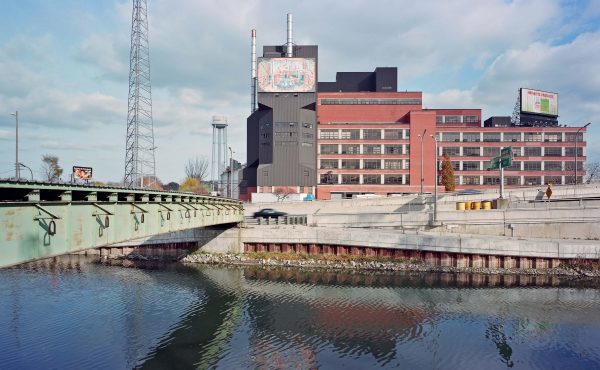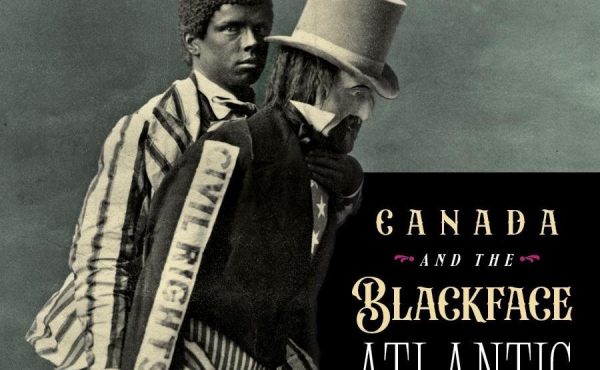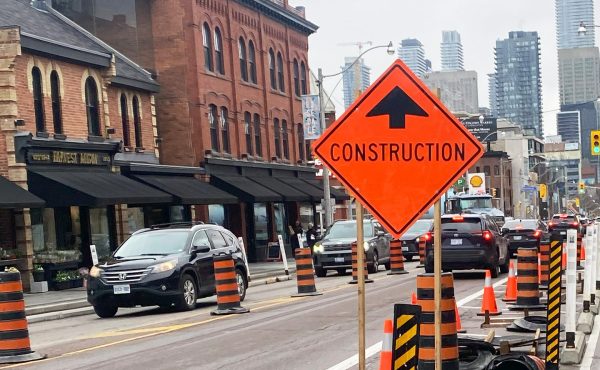
Christmas is done so you probably have money from Grand Ma or Weird Uncle to go “buy a present for yourself” because “you are too hard to buy for.” We’ve already listed a few book suggestions for Christmas last week — today we’ll add College Street Little Italy: Toronto’s Renaissance Strip from Mansfield Press to the list of books that are good to buy with that gift-money.
So many books that take a historic look at Toronto or its neighbourhoods (or any city) quickly become overly sentimental and take a slightly boring look backwards, relying on cute and folksy anecdotes, making it hard to get a real feel for what the place is or was like. This book isn’t one of those. It’s a mix of photos, photo-essays and thoughtful word-essays on the street. I haven’t been reading it front to back as it’s one of those encyclopedic books that you can open anywhere and meander through, much like you might explore College Street itself if you could do it with a time machine and your feet — psychogeographic reading, if there is a such a thing.
It is full of archival photos that aren’t all “the usual suspects” we see reprinted over and over. There are the familiar pics of the Crawford or Harbord Street bridges over unfilled Garrison Creek and the laying of TTC rails — but editors Denis De Klerck and Corrado Paina dug deep into the Toronto Archives and various personal collections to to find shots of men laying the Victorian bricks that would seal up the creek forever, circa 1910 billboards at College and Bathurst, early shots of the first installation of sewers in the area mixed with photos of Sophia Loren getting the royal treatment when she visited in the late 70s or cigarette-dangling-from-lips boccette players at the original Bar Italia.
Weaving in an out of the photographs are the essays that look at very different aspects of how the College Street we know today came together. Mark Fram’s piece 19th-century Suburbia 20th-century cool (or how to build a city street) describes the planning involved along College, and how the neighbourhoods were developed as subdivisions (not unlike Vaughan or Newmarket today — ok, a lot unlike those places, but same process but without car-focus screwing it up). If you live south of College on Shaw, Crawford or Harrison Street today, your house was part of the Crawford Estate, planned in 1885 by the Ontario Industrial Loan and Investment Company. Their ad from that year, reprinted in the book, reads much like condo-copy does today:
The rapid and, in fact, extraordinary growth of Toronto westward, induced the present proprietors a few years ago to acquire and lay before the Public in building lots of suitable size, the fine tract of land shown on this plan. Noticeable as was the growth of the City in this neighbourhood at that time, what must be said of it now? Whole fields of wasteland which not so long ago could be seen between Bathurst and Parkdale have given place to well-paved streets and avenues, filled with sightly and substantial buildings.
—
The onward march of the City of Toronto is assured; its Real Estate was never better worth purchasing than it is to-day.
—
Crawford street, forming the central line, is pleasantly situated, overlooking as it does, the attractive grounds of Trinity College, and running through the picturesque Bellwoods Park. The street having recently been block-paved, citizens will find it a pleasant drive along Crawford street and over the bridges which span the Garrison Creek ravine. Along this ravine and following the creek has been constructed the famous Garrison Creek sewer, over which it is proposed to form a public drive, in accordance with the scheme for parks and drives formulated by ex-Mayor McMurrich.
Other essays explore either the Italian, Jewish, and Portuguese activity on the street while Giuliana Colalillo’s essay Traces Left Behind: the “Other” Communities of College Street uncovers the less well known groups who have contributed to the College Street mix, the ones who don’t have the critical mass to have a continuous and visible street presence. Like the destitute Irish group who lived on Mansfield Avenue, the Lithuanians who arrived in the 1920s and the Latvians who took over the Freemason Hall (now called, of course, “The Latvian House”).
This book is deep and wide and smart. You should get it, then force the next person who tells you Toronto has no history, or that nothing interesting happens here, to read it. It’ll keep them busy for a while. What it does best is bring the historic right up to the present day — from rural “wasteland” to Broken Social Scene and Brazilian World Cup fans — showing how what happened back then is why this is here now, and why it all matters.




5 comments
Worst thing to befall College lately is the crude, disfiguring stucco surelevation of that “Venetian” apartment block btw/Shaw + Ossington. I guess they meant it to be “in character”, but, ecccchhh, that’s what you get when you put it in the hands of amateurs…
Good book suggestion. Those interested in Toronto literature featuring College Street might also want to pick up a copy of Olindo Romeo Chiocca’s College Street (Guernica Editions, 2005).
My copy’s on the reading pile, so I can’t offer a review yet, but here’s the blurb from the back cover:
“College Street is a quasi-pseudo biography of all the people, places, and events the author took for granted as a child and teenager, but
now wishes he could revisit and replay at will.
His vivid descriptions, through the eyes of a young child and teenager, bring this once fledgling neighborhood to life.
Dominated by the Portuguese and the Italians, the area was a continual confusion of weddings, funerals, feasts, and processions.
When you include the endless array of family events, obligation, dinners, and a required clandestine trip to Italy, life for Bruno was a boiling cauldron of what today’s multicultural fashionistas like to call “a cultural experience.â€Â
Sounds similar to a book by Rosemary Donegan that was published in 1985. Though now 20 years out of date, gives a very comprehensive history of Spadina Avenue, entitled, well, Spadina Avenue.
If anyone wants to see what the street looked like before the LRT, before Graduate House, the condos south of Queen, it’s very interesting. It also has a great collection of essays, anecdotes by residents, history of some of the buildings (including many archival photos of construction, and even the demolition of Bargain Benny’s), plus a lot on the Socalism and labour marches, the ethnic groups.
^Yeah, Spadina is a great book. Rosemary Donegan was also a great help to us in doing our Spadina [murmur] project, and also contributed some of her own stories.
That book was also part of a photo installation at the old A-Space gallery space (west side of Spadina, 100 meters north of queen, by that fur store. #204?). She said she was temped to remount it — i thought that would be a great idea, to see those changes. The book also has pictures of the Chinese garden that is now the Chinatown Centre (you can see bits of it in the Spadina Bus video).
Actually found that one harder than the ones Richard put up. ,